Blog Index
Want to discuss anything with Rod? Send him an email
2 Februuary 2021
Local birding, Cemeteries, Shoalhaven Birding, Retirement and Books
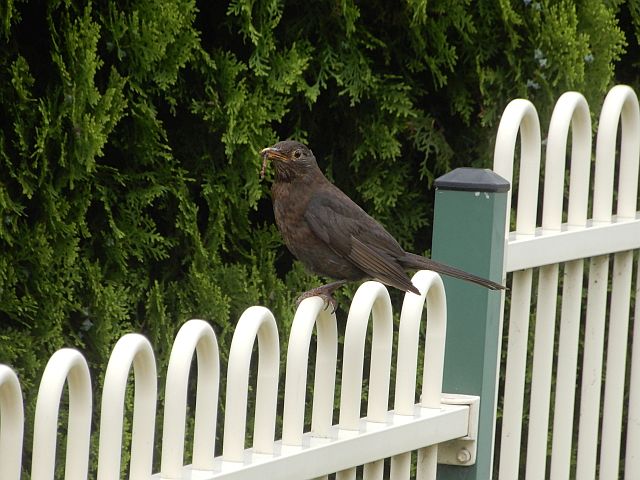
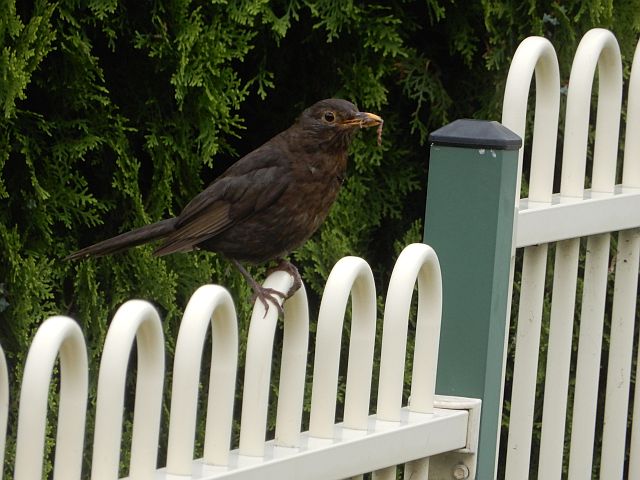 Little Missy, my favorite female Blackbird, made a return visit to my front yard just before the start of a new month. She is becoming a frequent visitor with some success catching grubs. Her species was originally imported from the UK and can be found in both Australia and New Zealand. It is not Little Missy’s fault, though, that her ancestors were brought here or to New Zealand. During the time when the British Empire had greater importance, and we had Empire Day celebrations, less care was taken of the environment and Australian and New Zealand ecosystems and so a lot of damage to these systems was done. Blackbirds are not the menace Indian Mynas are to Australian and New Zealand wildlife.
Little Missy, my favorite female Blackbird, made a return visit to my front yard just before the start of a new month. She is becoming a frequent visitor with some success catching grubs. Her species was originally imported from the UK and can be found in both Australia and New Zealand. It is not Little Missy’s fault, though, that her ancestors were brought here or to New Zealand. During the time when the British Empire had greater importance, and we had Empire Day celebrations, less care was taken of the environment and Australian and New Zealand ecosystems and so a lot of damage to these systems was done. Blackbirds are not the menace Indian Mynas are to Australian and New Zealand wildlife.
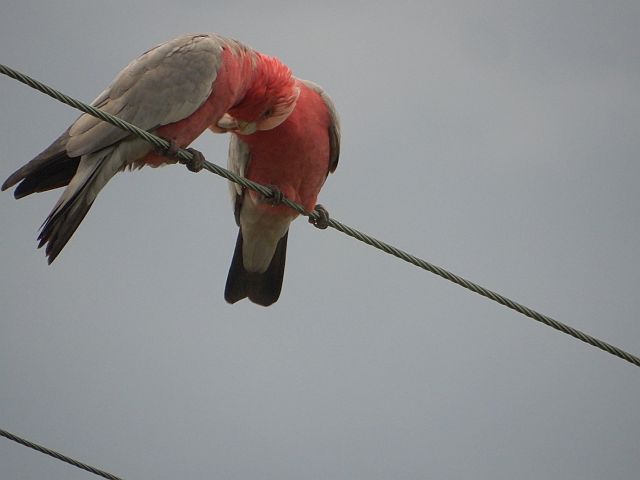
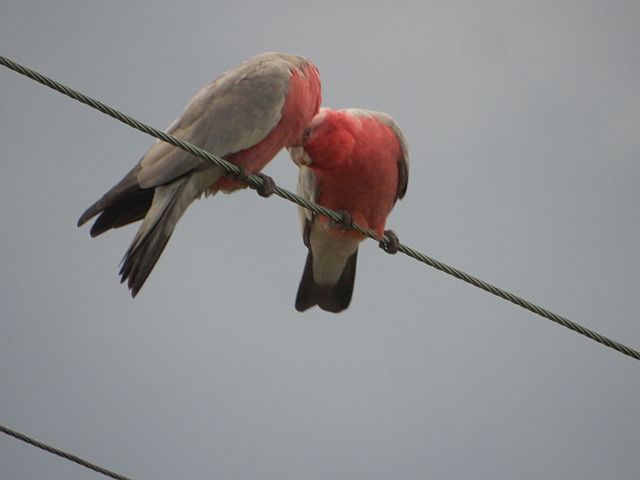 Just before the start of a new month there were two Galahs not far from where I live in the Illawarra. They were showing affection for one another. This is a common enough sight of a common enough species of bird but still something to write about and something overseas readers and viewers might enjoy experiencing. Gisela Kaplan, author of Bird Bonds, agrees with me that these particular birds are not dumb, as some people would have them, but highly intelligent.
Just before the start of a new month there were two Galahs not far from where I live in the Illawarra. They were showing affection for one another. This is a common enough sight of a common enough species of bird but still something to write about and something overseas readers and viewers might enjoy experiencing. Gisela Kaplan, author of Bird Bonds, agrees with me that these particular birds are not dumb, as some people would have them, but highly intelligent.
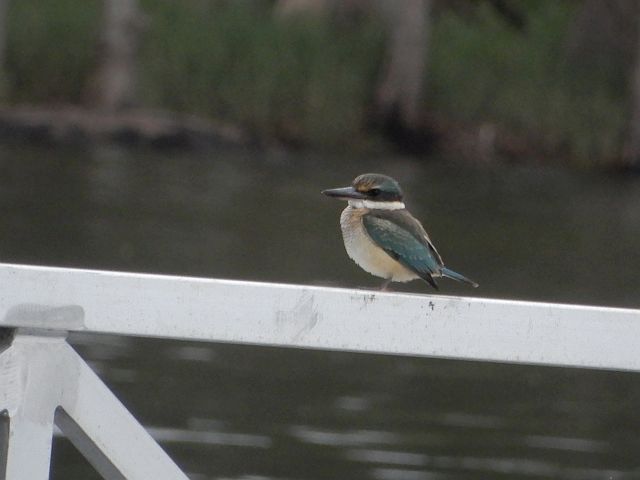
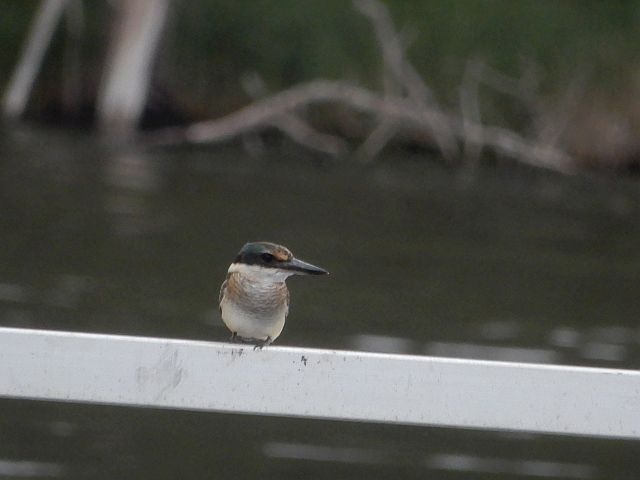 Some birding trips result in nothing much seen. Other trips, like the one I went on with Andrew Wood on the 28th of January, result in a great many sightings. It began in a small park in Gerringong we had been to before. It faces onto a waterway that should have lots of different kinds of wildlife in and about the water, trees and weeds. I saw a lone pelican, a Wattle Bird and an egret of some sort, probably a Great Egret. Not much to show for that body of water. Then Andrew spotted a Sacred Kingfisher on a fence and that made being at that little park more than just worthwhile. Despite the name, Sacred Kingfishers are small and often hard to find. This one seemed happy to pose for us. If the day had ended there it would have been wonderful enough but we pushed on to cliffs at Gerringong overlooking the sea.
Some birding trips result in nothing much seen. Other trips, like the one I went on with Andrew Wood on the 28th of January, result in a great many sightings. It began in a small park in Gerringong we had been to before. It faces onto a waterway that should have lots of different kinds of wildlife in and about the water, trees and weeds. I saw a lone pelican, a Wattle Bird and an egret of some sort, probably a Great Egret. Not much to show for that body of water. Then Andrew spotted a Sacred Kingfisher on a fence and that made being at that little park more than just worthwhile. Despite the name, Sacred Kingfishers are small and often hard to find. This one seemed happy to pose for us. If the day had ended there it would have been wonderful enough but we pushed on to cliffs at Gerringong overlooking the sea.

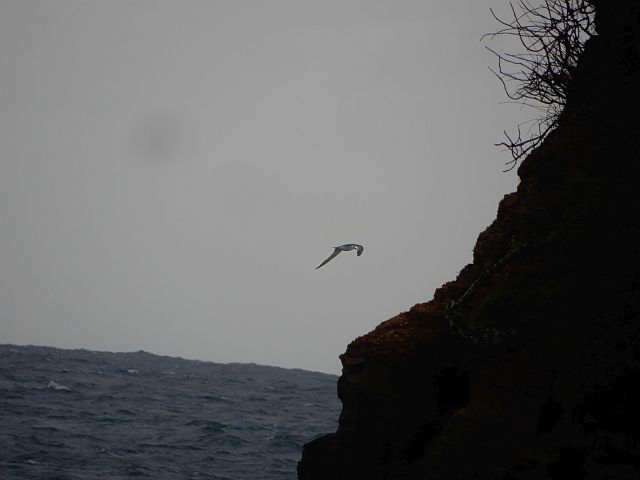 As with many a toilet block on the south coast of New South Wales, this one was decorated and there was the word Respect. The surf was up and there were wild waves crashing against the rocks. A couple of Terns and gulls flew past us and then we spotted a bird too brown to be a tern or a gull. It was our first bird of prey. It was a kestrel!
As with many a toilet block on the south coast of New South Wales, this one was decorated and there was the word Respect. The surf was up and there were wild waves crashing against the rocks. A couple of Terns and gulls flew past us and then we spotted a bird too brown to be a tern or a gull. It was our first bird of prey. It was a kestrel!
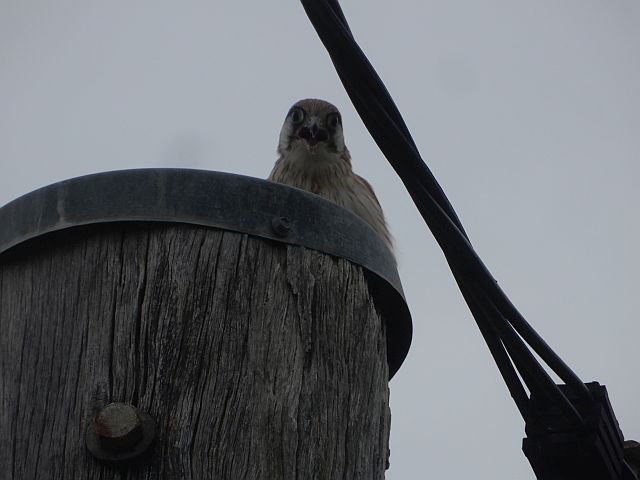
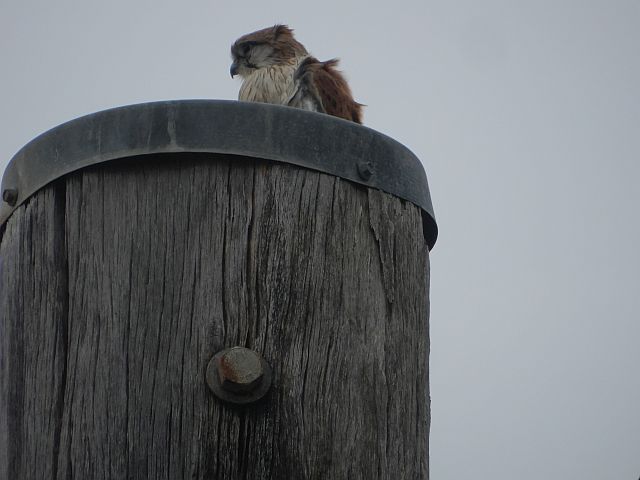 This kestrel was soon out of sight with no photo to show it was even there. Then it came back and sat for a while on a telegraph pole. I got a photo of this kestrel looking down at us, wondering what we were up to.
This kestrel was soon out of sight with no photo to show it was even there. Then it came back and sat for a while on a telegraph pole. I got a photo of this kestrel looking down at us, wondering what we were up to.
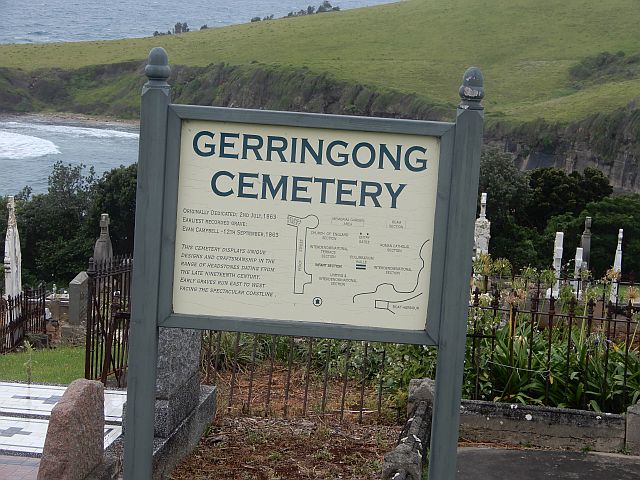
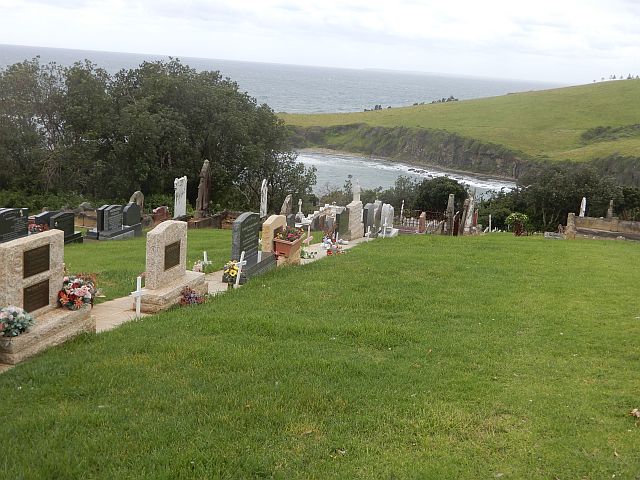 We went on to Gerringong Cemetery where there is a platform for whale watching constructed by the Lions Club of Gerringong and Kiama Municipal Council and opened to the public in 2007. No whales seen that day. I couldn’t help but think that the Gerringong Cemetery, so close to the sea, would be a great place to be buried when the time comes. As a spirit I can just imagine riding the air currents the way wild birds do.
We went on to Gerringong Cemetery where there is a platform for whale watching constructed by the Lions Club of Gerringong and Kiama Municipal Council and opened to the public in 2007. No whales seen that day. I couldn’t help but think that the Gerringong Cemetery, so close to the sea, would be a great place to be buried when the time comes. As a spirit I can just imagine riding the air currents the way wild birds do.
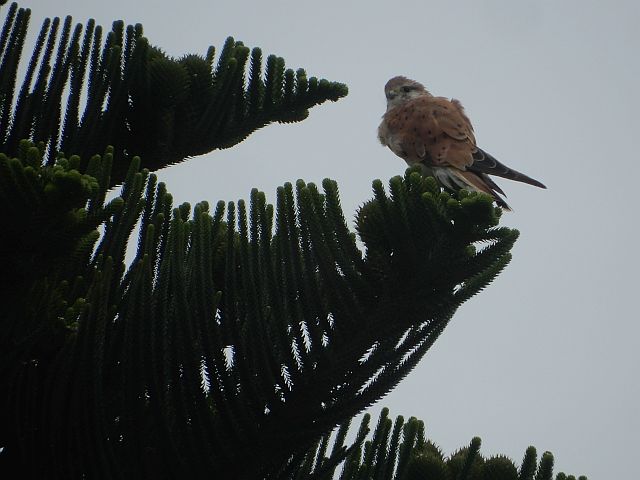
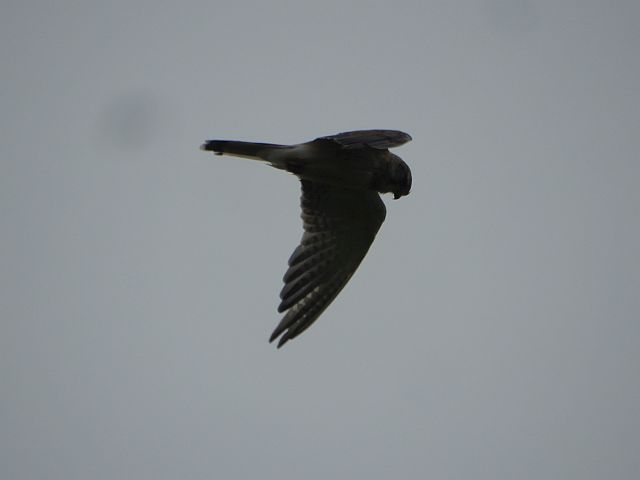 There were tall trees near the cemetery that were perfect for one kestrel to spy out to sea from and also look back at the land for prey. As it turned out, there was such a kestrel and we were able to catch him on camera riding the wind and hovering enough times to be photogenic in the air.
There were tall trees near the cemetery that were perfect for one kestrel to spy out to sea from and also look back at the land for prey. As it turned out, there was such a kestrel and we were able to catch him on camera riding the wind and hovering enough times to be photogenic in the air.
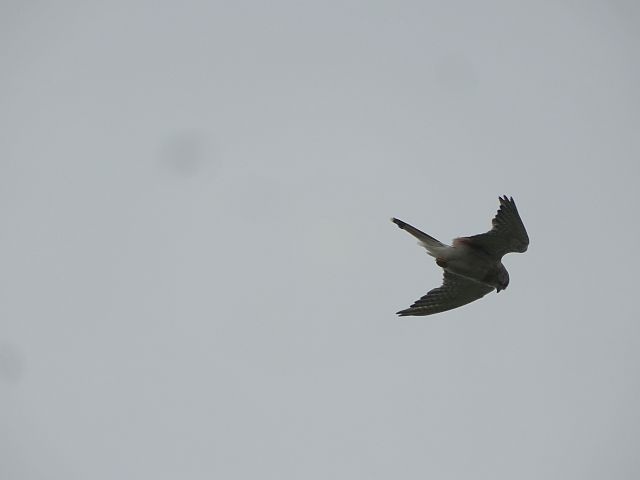
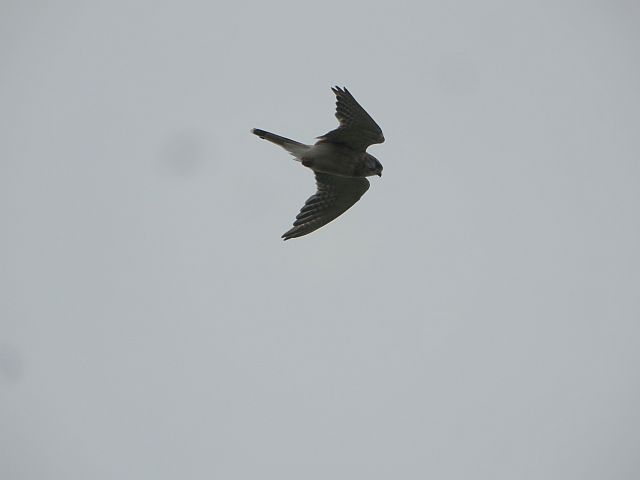 It is so easy to go camera happy when there is a bird of prey hovering and swooping in your vicinity. It is life in the wild and one is reminded of the old saying free as a bird which couldn’t be more wrong. Free? If the kestrel doesn’t score a small animal such as a mouse, a small lizard or an insect it will starve until the hunt is successful. It needs a high perch then, with high perches, there is the wind factor to consider. As a human spirit floating about this cemetery, though, I can imagine total freedom since I would no longer require food or shelter.
It is so easy to go camera happy when there is a bird of prey hovering and swooping in your vicinity. It is life in the wild and one is reminded of the old saying free as a bird which couldn’t be more wrong. Free? If the kestrel doesn’t score a small animal such as a mouse, a small lizard or an insect it will starve until the hunt is successful. It needs a high perch then, with high perches, there is the wind factor to consider. As a human spirit floating about this cemetery, though, I can imagine total freedom since I would no longer require food or shelter.
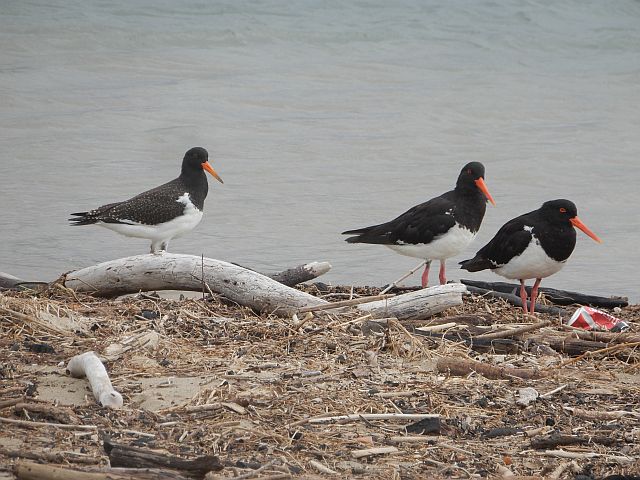 Shoalhaven Heads at first didn’t appear to be very promising. As we walked to the sandy area, we came across a worker spraying noxious growth that didn’t belong in the wild to keep it down. That no doubt was keeping wildlife away. The worker introduced us to a native plant that was edible. On the sand there were numerous Pied Oystercatchers. I photographed three together I dubbed the three amigos. One appears to be younger than the others.
Shoalhaven Heads at first didn’t appear to be very promising. As we walked to the sandy area, we came across a worker spraying noxious growth that didn’t belong in the wild to keep it down. That no doubt was keeping wildlife away. The worker introduced us to a native plant that was edible. On the sand there were numerous Pied Oystercatchers. I photographed three together I dubbed the three amigos. One appears to be younger than the others.
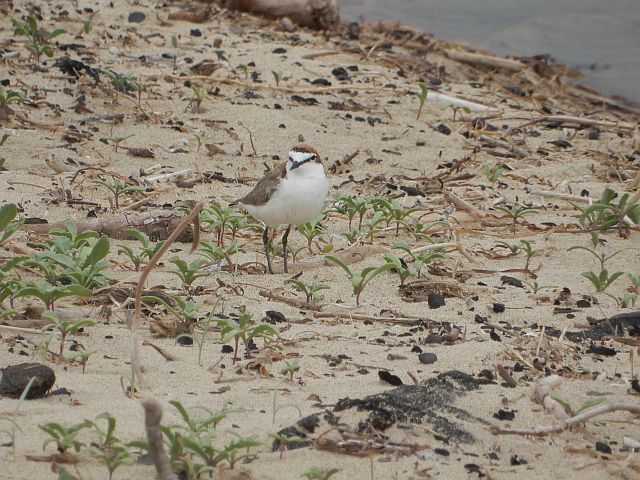
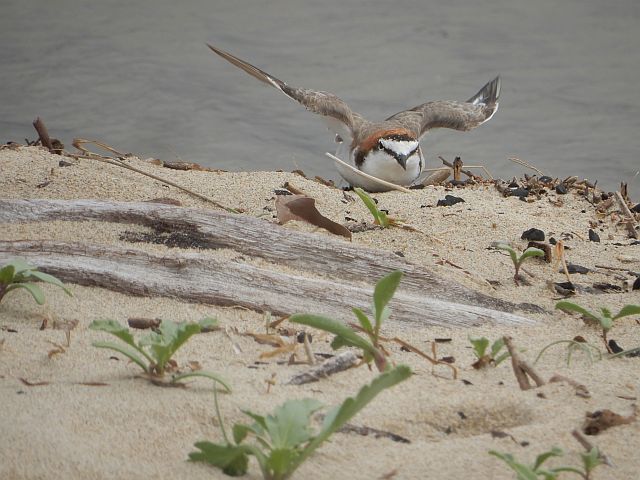 At Shoalhaven Heads, on the sand, I also came across a curious sight. Two Red-capped plovers were acting strangely, spreading their wings as if to take flight but remaining earth bound. They would scuttle along the sand and then repeat the wing spread. What were they up to? They were a distance away when their antics began but then they got closer and closer until I backed off. The last thing I wanted to do was risk them getting hurt by attacking me. They were far too small to pose any kind of a threat to a human such as myself but, if they ran into me, they might be injured and I couldn’t have that.
At Shoalhaven Heads, on the sand, I also came across a curious sight. Two Red-capped plovers were acting strangely, spreading their wings as if to take flight but remaining earth bound. They would scuttle along the sand and then repeat the wing spread. What were they up to? They were a distance away when their antics began but then they got closer and closer until I backed off. The last thing I wanted to do was risk them getting hurt by attacking me. They were far too small to pose any kind of a threat to a human such as myself but, if they ran into me, they might be injured and I couldn’t have that.
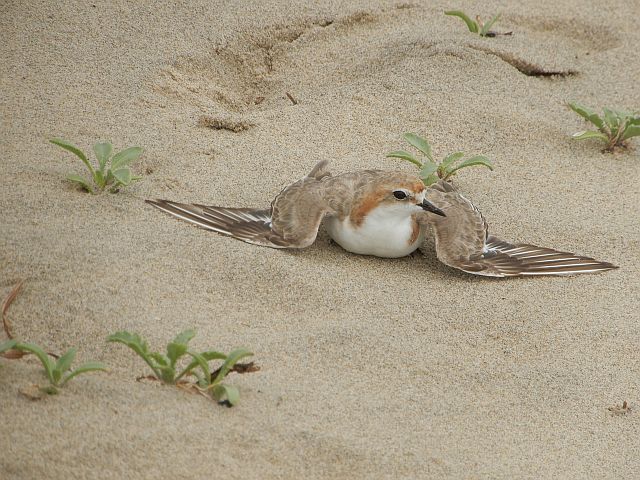
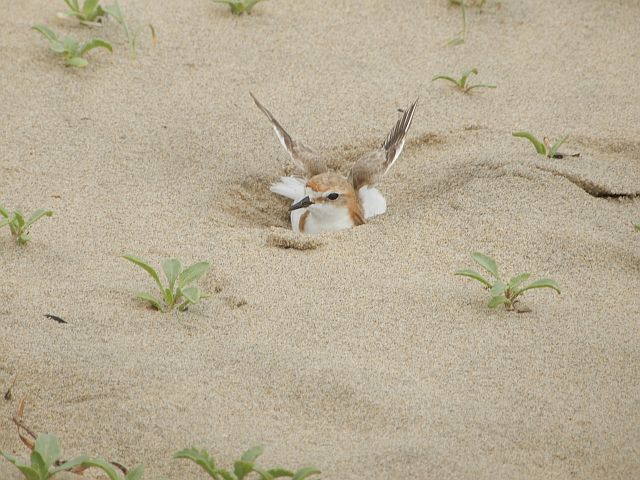 I showed some of my photos to local bird expert Terrill Nordstrom and I got my answer. They were pulling a con job. He referred to it as broken wing display. I was to go after them and away from either their eggs or their chicks. Truth to tell I had no idea at the time they had eggs or chicks or where these eggs or chicks might be found. I just hope I didn’t disturb them too much. Of course I would not have touched either eggs or chicks let alone done them any harm but those red-capped plovers weren’t to know that. No hard feelings on my part. I didn’t want to stress them out and hope I didn’t do so. I just wish they and their lot remain safe from foxes, dogs and also less than likeable humans.
I showed some of my photos to local bird expert Terrill Nordstrom and I got my answer. They were pulling a con job. He referred to it as broken wing display. I was to go after them and away from either their eggs or their chicks. Truth to tell I had no idea at the time they had eggs or chicks or where these eggs or chicks might be found. I just hope I didn’t disturb them too much. Of course I would not have touched either eggs or chicks let alone done them any harm but those red-capped plovers weren’t to know that. No hard feelings on my part. I didn’t want to stress them out and hope I didn’t do so. I just wish they and their lot remain safe from foxes, dogs and also less than likeable humans.
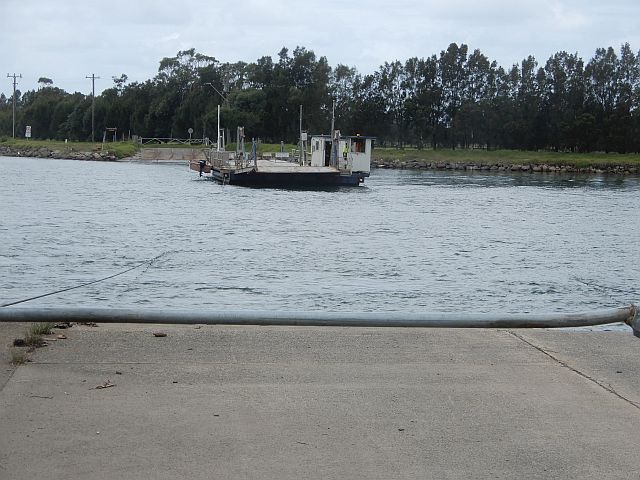
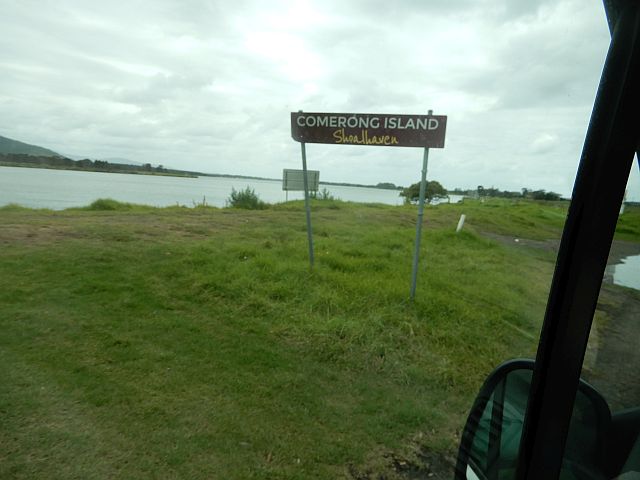 The last trip for the day was across in a ferry to Comerong Island. The journey across the water, once the ferry got going, took less than twenty minutes. I wondered if there were further surprises.
The last trip for the day was across in a ferry to Comerong Island. The journey across the water, once the ferry got going, took less than twenty minutes. I wondered if there were further surprises.
 There was a Sea Eagle I didn’t manage to photograph plus an Eastern Yellow Robin bursting with song. The sound from the Robin was high pitched, soft and melodic. I take it to be a male calling out to a female but there I could be wrong. Robins have been known to follow humans to see how much the earth they have dug up with their big feet. Loose soil means easier access to worms and other treats.
There was a Sea Eagle I didn’t manage to photograph plus an Eastern Yellow Robin bursting with song. The sound from the Robin was high pitched, soft and melodic. I take it to be a male calling out to a female but there I could be wrong. Robins have been known to follow humans to see how much the earth they have dug up with their big feet. Loose soil means easier access to worms and other treats.
 One of the highlights of the day was the discovery of a Pied Oystercatcher given a yellow tag which designated it as bird 35 in a study. I phoned up National Parks and Wildlife about 35 and discovered that volunteers had been tagging Pied Oystercatchers to keep tabs on them since they were now considered endangered. Like Red-capped plovers, they lay their eggs in sand which make their eggs easy targets of foxes and dogs. Arguably it will be through the efforts of the above mentioned volunteers that these birds and others will stand a chance of survival in the wild.
One of the highlights of the day was the discovery of a Pied Oystercatcher given a yellow tag which designated it as bird 35 in a study. I phoned up National Parks and Wildlife about 35 and discovered that volunteers had been tagging Pied Oystercatchers to keep tabs on them since they were now considered endangered. Like Red-capped plovers, they lay their eggs in sand which make their eggs easy targets of foxes and dogs. Arguably it will be through the efforts of the above mentioned volunteers that these birds and others will stand a chance of survival in the wild.
 Andrew pointed out a Dollarbird in flight to me and I managed to get a reasonable good picture of it when it landed. It originally took flight when it had spotted a cicada on the wing. Unfortunately for the bird it didn’t catch the cicada. I was told by Andrew he gets them in his own neighborhood. I haven’t seen a Dollarbird in the Corrimal/Towradgi area for some time now so was glad to see one on this island.
Andrew pointed out a Dollarbird in flight to me and I managed to get a reasonable good picture of it when it landed. It originally took flight when it had spotted a cicada on the wing. Unfortunately for the bird it didn’t catch the cicada. I was told by Andrew he gets them in his own neighborhood. I haven’t seen a Dollarbird in the Corrimal/Towradgi area for some time now so was glad to see one on this island.

 Walking through a swamp area, we came across two young women old enough to be university students. They had no fear at all handling live soldier crabs. In fact they enjoyed doing so. They reminded me of my sisters when they were younger and of trips we took up north to Iluka on holidays with our parents.
Walking through a swamp area, we came across two young women old enough to be university students. They had no fear at all handling live soldier crabs. In fact they enjoyed doing so. They reminded me of my sisters when they were younger and of trips we took up north to Iluka on holidays with our parents.
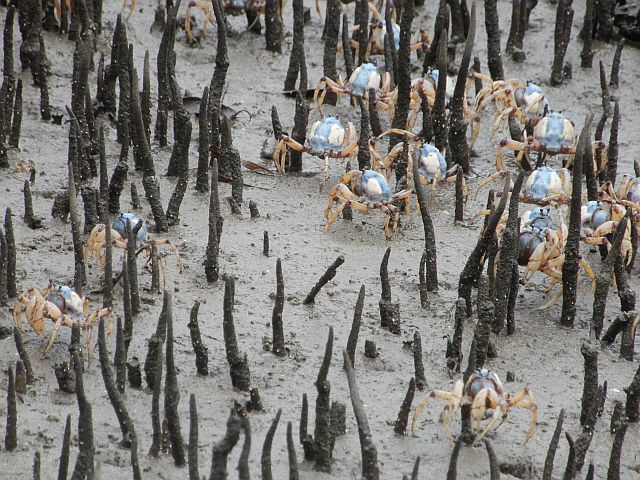
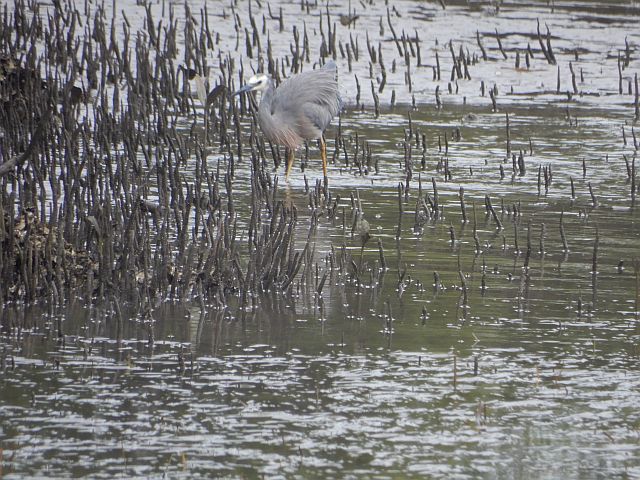 There were literally thousands of these soldier crabs around. We must have picked the right time of day for them to make an appearance outside their holes. There was also a White-faced Heron and in the bushes just off the road a Rufus Whistler. There were great many mosquitoes.
There were literally thousands of these soldier crabs around. We must have picked the right time of day for them to make an appearance outside their holes. There was also a White-faced Heron and in the bushes just off the road a Rufus Whistler. There were great many mosquitoes.
 On the way back to the ferry, we saw Grey Teal in a pond and Andrew got a photo of a Swamp Harrier, the third bird of prey for the day.
On the way back to the ferry, we saw Grey Teal in a pond and Andrew got a photo of a Swamp Harrier, the third bird of prey for the day.
January last year, in 2020, I came across these twenty-somethings on the internet complaining about the old age pension. I remember when I started out working after high school there was no such thing as superannuation or, if there was, very few workers knew about it and had it. By the time super became compulsory, it was too late for most people my age and older to accumulate enough super to live on for the rest of their lives. Add to this the stock market crash that occurred in the USA that had a devastating effect on super in the USA, the UK and Australia.
Why should older people get a pension? These self-righteous twenty-somethings asked when they didn’t expect to have a pension or need one. The answer is simple. For decades the older generation, my generation had put into the pension fund with their tax contributions. The twenty-somethings then snidely came back with how the federal government had already rummaged through those tax contributions so there was nothing of that money left. Letting people starve or work till they dropped then seemed to be these young people’s answer. How cruel!
These internet twenty-somethings were not like the wonderful young ladies I met on Comerong Island who would no doubt care about what happens to their grandparents and other older relatives. I tend to equate love of nature with a good disposition. Perhaps I am wrong in doing so but my sisters have led me in that direction and so has my nephew and nieces.
It was then pointed out to these internet twenty-somethings how uncertain the super they were accumulating might, in the end, be and how they could need a pension after all or starve or work till they dropped. Even blue chip investments made by one’s super can go wrong. It has happened before and it could happen again. Right now, with the corona virus, we are living in uncertain times and there may be even more uncertain times ahead.
Kaplan’s Bird Bonds continues to be a good read. It is amazing to learn that not all birds find their mate and some end up living alone or in a group for protection and nothing else. The more I look into intelligent birds the more human they become. Those birds who then do find a mate are indeed the lucky ones.

 Little Missy, my favorite female Blackbird, made a return visit to my front yard just before the start of a new month. She is becoming a frequent visitor with some success catching grubs. Her species was originally imported from the UK and can be found in both Australia and New Zealand. It is not Little Missy’s fault, though, that her ancestors were brought here or to New Zealand. During the time when the British Empire had greater importance, and we had Empire Day celebrations, less care was taken of the environment and Australian and New Zealand ecosystems and so a lot of damage to these systems was done. Blackbirds are not the menace Indian Mynas are to Australian and New Zealand wildlife.
Little Missy, my favorite female Blackbird, made a return visit to my front yard just before the start of a new month. She is becoming a frequent visitor with some success catching grubs. Her species was originally imported from the UK and can be found in both Australia and New Zealand. It is not Little Missy’s fault, though, that her ancestors were brought here or to New Zealand. During the time when the British Empire had greater importance, and we had Empire Day celebrations, less care was taken of the environment and Australian and New Zealand ecosystems and so a lot of damage to these systems was done. Blackbirds are not the menace Indian Mynas are to Australian and New Zealand wildlife.



























